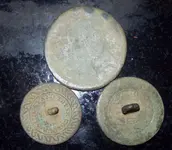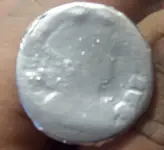IP is correct on the button, an early 1800s button that is just stating the Quality of the button in a slightly different matter, do not think it is anything too special, but is nice to have found one and glad you took notice of the backmark. Too many never even clean the back side of a plain button, and those are the ones who miss out on knowing if they have found a political or patriotic button that only had sayings on the backside!
Since another was found a few states away, I believe they are probably more common that thought. Added: Just noticed the period on the button so if there is no other period, the button's statement is: WILL STAND THEIR COLOUR which seems to make sense on being a quality b/m instead of THEIR COLOUR WILL STAND, which sounds more like a statement of some type.
As far as the coin goes, wish the photo was a tad better, but as you saying it reads wrong, well, I am doing a study on all my colonials and weighing all, measuring diameter on all, doing Specific Gravity on some that are suspect legit or counterfeit and also the main part of the study was to use the Digital Ferrous and Non Ferrous (Conductive) readings that the SE Pro, using the SR-1 probe and record where all the coins under controlled circumstances read on the detector.
William coppers happen in general to read lower in tone and crosshair and digital readings than most all of "coppers". I have recorded data on 28 of our William III Halfpence and the readings to vary but in general they are all lower than KGI, KGII, and even almost every KGIII Halfpence of which are all counterfeits in our collection. Now the KG II and KG III coppers that are cast countefeits, DO read lower, but again, William III Halfpence in my study of 28 ground found ones read low...
I assume the Explorer II has the double digital readout, so if you could, pass the two Williams you have under the coil, and it does not matter whether you use Conductive sounds or Ferrous sounds, the readings will remain the same. Just pass the coins evenly under the coil or probe in a smooth (flat not angled) manner and do it several times and the most common reading you get is what I would like to hear. I used the SR-1 Probe since it made it very easy to do it with one in the house.

I will let you know how they compare with my study in a PM, which I do not want to post at this time, due to possibly publishing the results in the future.
Don






 gratz on the William III Halfpenny or farthing ( late 1600s-1700 i think) might be time to rename your site
gratz on the William III Halfpenny or farthing ( late 1600s-1700 i think) might be time to rename your site 
 TNET is the best for iding.
TNET is the best for iding.
 It makes my head spin!
It makes my head spin!